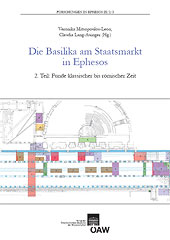


Im Band FiE IX/2/3, 2. Teil, wird das bisher unpublizierte Fundmaterial aus den Grabungen der Basilika am Staatsmarkt der sechziger und siebziger Jahre des 20. Jhs. vorgestellt. Anhand der Dokumentation konnte einer der Vorgängerbauten der Basilika – eine Stoa – definiert werden, die um 200 v. Chr. errichtet wurde.
Zwei verschiedene Füllschichten waren zu beobachten, eine unter dem Stylobat der hellenistischen Stoa, darüber eine 1,2 m hohe, um das Gehniveau der Basilika zu erhalten.
Bis zur Gründung der hellenistischen Stadt lagen in diesem Areal Gräber entlang der Prozessionsstraße. Die Funde von Webgewichten, Gefäßmodeln, Matrizen sowie zahlreiche Lampen sind Belege für nachfolgende Siedlungen und Werkstätten. Den historischen Ereignissen entsprechend dominieren die rhodischen Amphoren das Fundmaterial des 3. Jhs. v. Chr., ehe sie von lokalen Produktionen abgelöst wurden.
Etwa im letzten Viertel des 3. Jhs. wichen die privaten Bauten zugunsten der Stoa, die wiederum Ende des 1. Jhs. v. Chr. geschliffen wurde, um Platz für den Bau der Basilika zu schaffen. Einige der Funde wie Glas und Münzen belegen eine Nutzung bis in das 7. Jh.
Gedruckt mit Unterstützung des Fonds zur Förderung der wissenschaftlichen Forschung (FWF).

…
It is the preceding volume FiE IX/2/3, Part 2, which completes the documentation and interpretation of the finds of the excavations of the Basilika am Staatsmarkt of the sixties and early seventies of the last century. Thus we obtained important results for Ephesian research, confirming that an earlier building construction – a Hellenistic stoa – in this area of the city took place about 200 BC. Two different fills could be extracted: one under the stylobat of the Hellenistic stoa and another 1,2m above this stylobat brought up for the walking ground of the early Roman Basilika. The area was the cemetery which was used till the Hellenistic Ephesos was founded. The moulds for ceramic vessels, lamps and terracottas as well as the loom weights give evidence for private housing and workshops in this area before the stoa was constructed. According to the historical facts the main assemblage of amphora stamps belongs to the first half of 3rd century B.C. and is dominated by Rhodes. By the late 3rd century and continuing to the middle of the 2nd century the local region's presence becomes more clearly indicated. In the late 3rd century the private buildings in this area were demolished to build up the stoa; and in the end of the 1st century the stoa was pulled down bit by bit to give place for the Basilika. Some of the finds like glass, lamps and most of the coins give prove of its existence till the 7th century.
2007,
978-3-7001-3733-7
978-3-7001-3983-6
212 Seiten, zahlr. Farb- und SW-Abb.,
29,7x21cm, broschiert